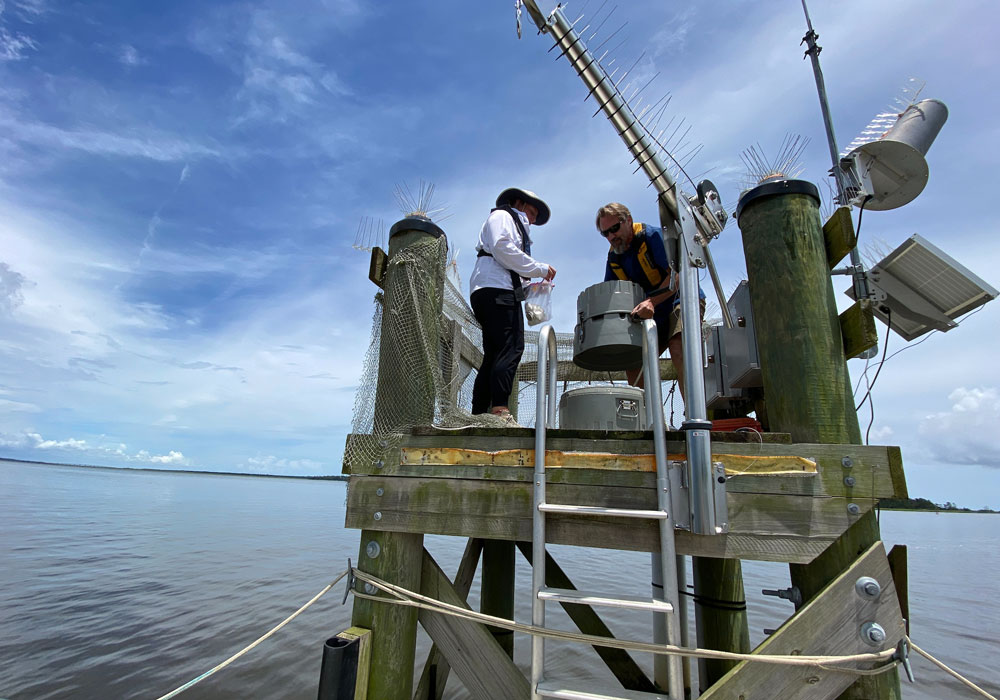Around the clock and every day of the year for the past three decades, an environmental monitoring system has been keeping a finger on the pulse of 30 diverse estuaries across the country, collecting water quality and weather data.
Nestled on the nation’s coasts and in Puerto Rico, the estuaries were designated as research sites more than 50 years ago by the National Oceanic and Atmospheric Administration, and two decades later the integrated System-Wide Monitoring Program and Centralized Data Management Office, headquartered in Georgetown, S.C., at USC’s Belle W. Baruch Institute for Marine and Coastal Sciences, were created.
“Our SWMP was designed to assess short-term variability and long-term change in estuaries, which are vital buffer zones between land and sea and breeding grounds for many marine species,” says Dwayne Porter, director of NOAA’s Centralized Data Management Office in Georgetown, which assimilates, manages, integrates and disseminates data and derived information from the sites. He holds joint faculty appointments in USC’s Arnold School of Public Health and the Baruch Institute.
“One thing that's common across all the sites is that we're dealing with a changing climate, and that's impacting water temperature and all the variables that are collected. Monitoring programs like this provide sound science to address quality of life issues because oftentimes the quality of our environment impacts the quality of public health and our lives.”
“The backbone of this program is to maintain these data sets and allow researchers to use them to better understand any changes that occur over time. The system is also taking on additional data sets like vegetation monitoring — looking at marsh grasses and plants and potential inundation from sea-level rise.”
Porter referenced a water monitoring station at an estuarine research reserve site on the West Coast that suddenly detected a significant decrease in dissolved oxygen. The culprit was a large body of bacteria-laden water moving past the monitoring station, and local agencies were able to trace its source and work with local communities to address the problem.
“One of the values of having real-time telemetered data is that it can be a community notification system,” says Melissa Ide, deputy director of the Centralized Data Management Office and a Baruch Institute associate. “The backbone of this program is to maintain these data sets and allow researchers to use them to better understand any changes that occur over time. The system is also taking on additional data sets like vegetation monitoring — looking at marsh grasses and plants and potential inundation from sea-level rise.”
Scientists aren’t the only ones using data from the estuarine research reserve sites. Porter points to coastal communities that are becoming more engaged in understanding how the environment affects their quality of life.
“In South Carolina we have a number of coastal communities that are underserved — environmental justice communities — and we spend a lot of time educating them about the dynamic of environmental data and public health,” Porter says. “The uses of the data we collect have far exceeded anything we ever imagined when we put this system together 30 years ago.”
Two of the 30 NOAA estuarine research sites are in South Carolina — the ACE Basin in Charleston and North Inlet-Winyah Bay near Georgetown, which is also the site of USC’s Baruch Institute.
“We have been recognized as a national model for how to implement an end-to-end environmental monitoring system,” Porter says. “We've been contracted by other entities, such as the Florida Department of Environmental Protection, to help them design, implement and manage a SWMP-like monitoring and end-to-end data and information management program. Our facility here in Georgetown that hardly anyone knows about actually has a much greater recognition nationally than it does in South Carolina and Georgetown County.”
